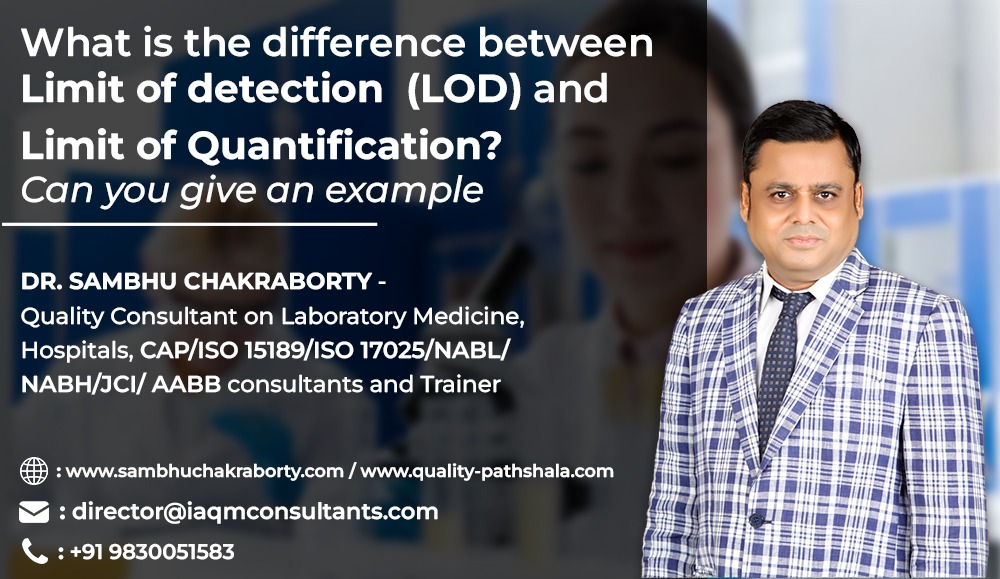Limit of Detection (LOD) and Limit of Quantification (LOQ) are two important concepts in analytical chemistry used to assess the sensitivity of an analytical method. They both help to determine the lowest concentration of an analyte that can be reliably detected and quantified, respectively.
1. Limit of Detection (LOD): The Limit of Detection (LOD) is the lowest concentration of an analyte that can be reliably distinguished from the background noise with a certain level of confidence. In other words, it is the lowest concentration at which the presence of the analyte can be detected, but not necessarily quantified accurately. The LOD is typically defined as having a signal-to-noise ratio (S/N) of 3:1 or 2:1, depending on the specific method or standard used.
Example. : Let’s say you are analysing a water sample for the presence of a particular pollutant using a sensitive instrument like High-Performance Liquid Chromatography (HPLC). If the LOD for this pollutant is 0.5 parts per billion (ppb), it means that you can reliably detect its presence in the water sample when it reaches or exceeds 0.5 ppb, but you cannot accurately quantify the exact concentration below that level.
2. Limit of Quantification (LOQ): The Limit of Quantification (LOQ) is the lowest concentration of an analyte that can be reliably detected and quantified with acceptable accuracy and precision. Unlike the LOD, which only focuses on detection, the LOQ ensures that the measured concentration falls within an acceptable range of uncertainty, allowing for accurate quantification.
Continuing with the previous example, if the LOQ for the pollutant in the water sample is 1 ppb, it means that you can not only detect the pollutant when it reaches or exceeds 1 ppb, but you can also accurately determine its concentration with acceptable precision
In summary, the LOD is the lowest concentration at which the analyte’s presence can be detected, while the LOQ is the lowest concentration that can be both detected and quantified accurately. The LOQ is typically higher than the LOD, as it requires a higher level of sensitivity and precision in the analytical method. Both LOD and LOQ play crucial roles in determining the sensitivity and reliability of analytical techniques, especially in fields such as environmental monitoring, pharmaceutical analysis, and food safety testing.
Example: Detection and Quantification of Blood Glucose
Limit of Detection (LOD): In this case, the Limit of Detection (LOD) would represent the lowest concentration of blood glucose that can be reliably detected but not necessarily accurately quantified. Let’s assume that the LOD for blood glucose using a particular assay is 10 mg/dL.
If a patient’s blood glucose level falls below 10 mg/dL, the assay may still be able to detect its presence, indicating that the patient has some glucose in their blood. However, the exact concentration cannot be precisely determined or quantified below this level
Limit of Quantification (LOQ): On the other hand, the Limit of Quantification (LOQ) represents the lowest concentration of blood glucose that can be reliably detected and accurately quantified with acceptable precision. In this example, let’s say that the LOQ for blood glucose using the same assay is 50 mg/dL.
If a patient’s blood glucose level is above 50 mg/dL, the assay can accurately quantify the concentration with acceptable precision, allowing healthcare professionals to make informed decisions regarding the patient’s glucose management.
So, for the given assay:
LOD: 10 mg/dL (Blood glucose levels below 10 mg/dL can be detected but not accurately quantified)
LOQ: 50 mg/dL (Blood glucose levels above 50 mg/dL can be accurately quantified)
These values would be essential in determining the sensitivity and reliability of the blood glucose assay in the medical laboratory. Ensuring an appropriate LOD and LOQ helps healthcare professionals make accurate diagnoses and decisions based on the test results
About the author
Dr. Sambhu Chakraborty is a distinguished consultant in quality accreditation for laboratories and hospitals. With a leadership portfolio that includes directorial roles in two laboratory organizations and a consulting firm, as well as chairmanship in a prominent laboratory organization, Dr. Chakraborty is a respected voice in the field. For further engagement or inquiries, Dr. Chakraborty can be contacted through email at director@iaqmconsultants.com and info@sambhuchakraborty.com. Additional resourcesand contact information are available on his websites, https://www.quality-pathshala.com and https://www.sambhuchakraborty.com, or via WhatsApp at +919830051583

Many thanks Professor
Great blog!
What’s Limit of blank?
Thanks
What will be the result by method if blood glucose is above LOD but below LLOQ?